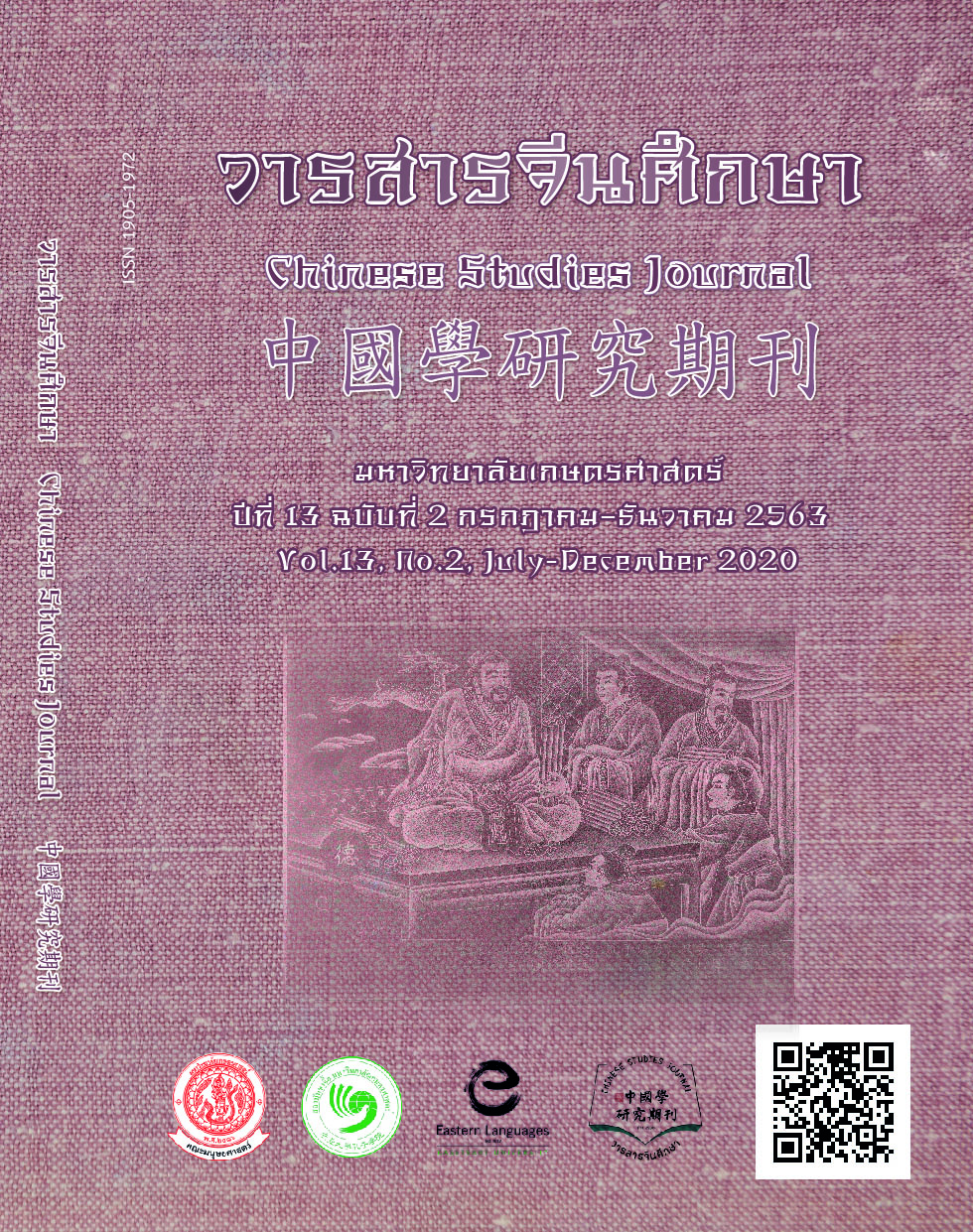The Comparative Analysis of Chinese and Thai Order of Modifiers
Main Article Content
Abstract
In Chinese language teaching, Thai students have many problems about the Chinese word order of modifiers, because the Chinese word order is not the same as the word order of Thai language. Therefore, the researcher is interested in studying the position of these modifiers. This research ‘s objectives are to comparatively analyze the word order of 定语 (Attributive) 状语 (Adverbial) and 补语 (Complement) in Chinese and Thai, in order to be useful to students in learning Chinese grammar about word order of modifiers.
This research found out that: in terms of the positions of multiple attributives, the positions of multiple attributives in Chinese are: (1) collar nouns, pronouns; (2) time words and place words; (3) quantitative/ specific pronoun-phrases classifier (the descriptive attributive words are followed); (4) subject-predicate phrases, verbs (phrases), prepositional phrases; (5) quantitative-phrases classifier (previously restricted attributives); (6) adjectives (phrases) and other descriptive words; (7) adjectives without "de" and descriptions noun . However, the positions of multiple attributives in Thai are: (1) nouns that indicate collar attributes; (2) adjectives (phrases); (3) subject-verb phrases, verbs (phrases); (4) quantitative/specific pronoun- phrases classifier; (5) time words and place words; (6) pronouns.
In terms of the position of multiple adverbials, the positions of multiple Chinese adverbials are: (1) adverbial for time; (2) adverbial for mood; (3) adverbial for describing actors; (4) purpose, basis, and concern cooperative adverbials; (5) adverbials expressing direction and direction; (6) adverbials indicating objects; (7) adverbials describing actions. However, the positions of multiple adverbials in Thai are: (1) adverbials describing actions; (2) adverbials indicating objects; (3) adverbials indicating places and directions; (4) indicating purpose and basis, related, and cooperative adverbials; (5) adverbials describing actors; (6) adverbials expressing mood; (7) adverbials expressing time.
As for the position of the complement, when the sentence has no object, the position of the Chinese-Thai complement is the same, that is, the complement is placed after the verb or adjective. When the sentence has an object, the position of the Chinese-Thai complement is different, for example: Chinese result complement, the object is placed after the result complement, but Thai result complement, the object can be placed in two positions, before the result complement or placed after the complement, etc.
Article Details
ผลงานทางวิชาการที่ลงตีพิมพ์ในวารสารจีนศึกษา มหาวิทยาลัยเกษตรศาสตร์ เป็นลิขสิทธิ์ของผู้เขียนหรือผู้แปลผลงานนั้น หากนำลงในวารสารจีนศึกษาเป็นครั้งแรก เจ้าของผลงานสามารถนำไปตีพิมพ์ซ้ำในวารสารหรือหนังสืออื่นได้โดยมิต้องแจ้งให้ทราบล่วงหน้า แต่หากผลงานที่ได้รับพิจารณานำลงในวารสารจีนศึกษา เป็นผลงานที่เคยตีพิมพ์ที่อื่นมาก่อนเจ้าของผลงานต้องจัดการเรื่องปัญหาลิขสิทธิ์กับแหล่งพิมพ์แรกเอง หากเกิดปัญหาทางกฎหมาย ถือว่าไม่อยู่ในความรับผิดชอบของวารสารจีนศึกษา มหาวิทยาลัยเกษตรศาสตร์ ทั้งนี้ ความคิดเห็นต่างๆ ในบทความเป็นความคิดเห็นส่วนตัวของผู้เขียน ไม่เกี่ยวกับกองบรรณาธิการวารสารจีนศึกษา มหาวิทยาลัยเกษตรศาสตร์
References
李燕华.(2015).泰国学生汉语作文中的语序偏误分析.江西师范大学硕士学
位论文.
刘月华等.(2004).实用现代汉语语法.北京:商务印书馆.
石庭瑞.(2014).俄语背景学生汉语学习中语序偏误问题探究---以汉语定
语、状语、补语为例.兰州大学硕士学位论文.
颜雪云.(2009).汉泰状语的比较.北京语言大学硕士毕业论文.
กำชัย ทองหล่อ. (2552). หลักภาษาไทย. กรุงเทพฯ : รวมสาส์น.
นมลรัตน์ แย้มวงศ์. (2559). An Analysis of Adverbial Structures in Chinese and
Thai Languages. วารสารจีนวิทยา มหาวิทยาลัยแม่ฟ้าหลวง ฉบับปีที่ 10 เดือน
สิงหาคม.
นววรรณ พันธุเมธา. (2554). ไวยากรณ์ไทย. กรุงเทพฯ: โรงพิมพ์มหาจุฬาลงกรณ์ราชวิทยาลัย.
นิตยา กาญจนะวรรณ. (2542). การวิเคราะห์โครงสร้างภาษาไทย. กรุงเทพฯ : สำนักพิมพ์
มหาวิทยาลัยรามคำแหง.
เรืองเดช ปันเขื่อนขัติย์. (2552). ภาษาศาสตร์ภาษาไทย. กรุงเทพฯ: โรงพิมพ์มหาจุฬาลงกรณ์
ราชวิทยาลัย.
วิจินตน์ ภาณุพงศ์. (2530). โครงสร้างของภาษาไทย. กรุงเทพฯ : สำนักพิมพ์มหาวิทยาลัย
รามคำแหง.
วิเชียร เกษประทุม. (2557). หลักภาษาไทย(ฉบับสมบูรณ์). กรุงเทพฯ : สำนักพิมพ์ พ.ศ.
พัฒนา จำกัด.


